
FHWA-HEP-09-026
This section of the report provides a unique view into how MPOs and State DOTs translate SAFETEA-LU provisions and FHWA guidance into innovative and valuable projects in the field. The projects highlighted here represent efforts that the interviewed MPOs felt were successful in areas such as:
These project descriptions point to the variety of CMAQ activity across the country and provide a closer examination into the range of processes, projects, relationships, and impacts the CMAQ program is generating at a small sampling of agencies Nationwide. Through these project descriptions, readers will gain insight into how SAEFTEA-LU requirements and FHWA guidance are being used by States and MPOs to solicit, evaluate, and program proposed CMAQ projects at the state and local level.
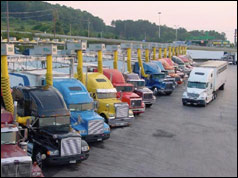
Location: Birmingham, Alabama
Cost: $1.8 million total, $170,000 in CMAQ funds
Project sponsor: Alabama Partners for Clean Air (APCA)
Estimated annual emissions reduction benefits:
| Pollutant | Est. Annual Emissions Reduction (kg/yr) |
|---|---|
| Ozone | 148 |
| Ozone NOx idle emissions factor | 2,920 |
| PM 2.5 (standard PM) | 80 |
The partnership comprised 11 organizations, including the Alabama Department of Environmental Management (ADEM), the Jefferson County Department of Health, and the Alabama Trucking Association.
APCA worked with public- and private-sector firms to package this proposal. The private sector agreed to provide the electrification location, and the public sector agreed to provide some start-up financial assistance. The project was then proposed to Regional Planning Commission of Greater Birmingham (RPCGB).
The purpose of this project is to improve air quality by reducing the exhaust from idling engines. An idling diesel engine consumes about one gallon of fuel per hour. The exhaust from the idling engines contains numerous pollutants, including nitrogen oxide (NOx), carbon monoxide (CO), and volatile organic compounds (VOCs). Because truck drivers are required to get several hours of rest to ensure safe driving, they normally keep engines idling at truck stops during rest periods to provide heating and air conditioning in the cab and sleeping area as well as power for various appliances. The Truck Stop Electrification project is a partnership with a private-sector truck stop to install technology that allows truck drivers to shut off their engines while idling and to hook up a window adaptor that provides the truck with required heating and cooling, electricity, and communications services. The project includes the capital cost to install and operate the technology.
Using Environmental Protection Agency emissions factors for calculating air quality benefits, it was estimated that the cost-effectiveness for reductions in NOx was approximately $34 per kilogram per year.
This project was part of an APCA package of proposals that was sent to the Metropolitan Planning Organization (MPO) Interagency Consultation Group to determine whether projects were eligible for CMAQ funding. Once this project was deemed eligible, the MPO Transportation Improvement Program (TIP) Subcommittee voted to allocate CMAQ funding to it.
The project has been in operation since 2004, and the operator has collected data on how frequently the electrification technology is used. Based on the frequency of use data, APCA estimated that the project saved 178,000 gallons of diesel fuel in 2007 and reduced pollutants by 1,900 metric tons.
In addition to the air quality benefits, the project sponsor noted other benefits such as energy independence through fuel savings, economic development, and the provision of better working conditions for the truck drivers.

Location: Massachusetts Statewide
Cost: $16.4 million in total CMAQ funding over 3 years
Project sponsor: Massachusetts Department of
Environmental Protection (MassDEP) and Executive Office of
Energy and Environmental Affairs (EOEEA)
Estimated annual emissions reduction benefits:
| Pollutant | Est. Annual Emissions Reduction (kg/yr) |
|---|---|
| CO | 602,573 |
| HC* | 30,129 |
| PM | 1,998 |
Project partners were the Massachusetts Executive Office of Transportation (EOT), MassDEP, and the EOEEA.
Massachusetts' two State environmental agencies, EOEEA and MassDEP, submitted a proposal to the Massachusetts EOT for a Statewide program to retrofit the diesel engines in all school buses across the Commonwealth.
The project provides diesel oxidation catalysts (DOCs) and crankcase filters (CCFs) for approximately 7,800 school buses in Massachusetts and will result in all school buses in the Commonwealth being retrofitted by 2010. EOEEA sponsored this project because retrofitting school buses with new technologies that address both external and in-cabin exposure to pollutants will provide significant air quality benefits at a relatively low cost.
EOT has transferred the funds to MassDEP to manage. The Agency coordinates directly with each of the school districts and bus operators to complete the work.
To calculate the air quality benefits, MassDEP used the Environmental Protection Agency diesel emissions quantifier model, which is available online at: http://www.epa.gov/cleandiesel/quantifier/. The model estimated that installing DOCs and CCFs on older school buses Statewide would reduce carbon monoxide (CO) and HC emissions by 80 percent, and particulate matter (PM) emissions by 25 percent. Annual emissions reductions in kilograms were calculated for each pollutant and a cost-effectiveness rate was then determined. The estimated cost to reduce a kilogram of CO is about $30, while HC reduction is estimated at $597 per kilogram.
This project was part of the Statewide CMAQ program overseen by the Massachusetts EOT. Upon receiving the submission from MassDEP, EOT included the proposal on the agenda for the CMAQ Consultation Committee to determine its eligibility. After the project was recommended for funding, the committee referred the project back to EOT, for inclusion on the State Transportation Improvement Program (STIP). There is no formal evaluation committee to review Statewide CMAQ projects.
A post-project evaluation has not been conducted for this program because it is still in its implementation phase.
EOT believes that this project is a good example of the benefits of having a Statewide CMAQ program that can promote broader programs and projects that generate benefits across multiple Metropolitan Planning Organization (MPO) boundaries. As a result of the project, diesel engines in school bus fleets will be retrofit throughout the entire state, resulting in substantial air quality benefits at relatively low cost.
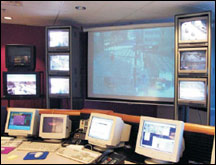
Location: Denver, Colorado
Cost: $3.9 million (in FY08) in CMAQ funding
Project sponsors: Denver Regional Council of Governments (DRCOG)
Estimated annual emissions reduction benefits:
| Pollutant | Est. Annual Emissions Reduction (kg/yr) |
|---|---|
| CO | 656,932 |
Project partners included DRCOG, Colorado Department of Transportation (CDOT), local jurisdictions that operate traffic signals, and CDOT Regions 1, 4, and 6 (in all, 32 stakeholder entities).
TSSIP is one of six programs that now receive dedicated CMAQ funds, due to their long history and demonstrated success at meeting CMAQ goals in the Denver region. At the beginning of each Transportation Improvement Program (TIP) update cycle, DRCOG determines the specific funding commitments to these six programs. DRCOG updates the TSSIP generally on a 4-year cycle, programming 6 years of funding at a time.
The overall purpose of TSSIP is to reduce travel time and vehicle emissions within the DRCOG Transportation Management Area (TMA). The program involves both capital and traffic signal timing improvements on a regional level. The capital improvements, which are prioritized according to a FY 2008-2012 schedule, involve providing equipment and installing communications links to facilitate traffic signal timing. The traffic signal timing component coordinates more than 3,500 traffic signals across 32 jurisdictional boundaries and on all major roads in the DRCOG TMA. Signals are generally coordinated via time-of-day (TOD) plans such as "morning peak," "off-peak," and "afternoon peak." The TOD plans are updated on a 3- to 5-year basis for each corridor. TSSIP was implemented in 1994, programming an initial 6 years of funding, and was updated in 1996, 1999, 2003, and 2007.
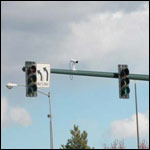
The air quality benefits are assessed on the basis of travel times and the number of stops measured in the corridors where timing was revised. Benefits from the capital improvement component of the program are reflected by subsequent corridor traffic signal timing improvements. With each signal retiming project, TSSIP expects to reduce corridor travel time by 5 to 15 percent. For 2007, TSSIP reported a savings of approximately 2.2 million vehicle-hours traveled and 1.4 million kilograms of carbon monoxide (CO) emissions.
After a call for projects, DRCOG staff worked extensively with regional traffic signal operating agencies to verify current conditions, identify critical needs, and program upcoming funding. A copy of the summary report for the most recent funding cycle may be found at http://www.drcog.org/documents/TSSIP%202007%20Summary%20Report.pdf.
DRCOG conducts a post-project evaluation for every TSSIP project. The results of each evaluation are summarized in a project brief that is distributed to interested parties in the region. Annually, DRCOG summarizes the results of all completed projects for the CMAQ Reporter.
DRCOG believes that the CMAQ program has allowed the Agency to fund more air-quality-focused projects, including TSSIP, and has strengthened its working relationship with Regional Air Quality Council (Colorado). DRCOG also believes that the CMAQ program has allowed the Agency to focus explicitly on how transportation affects air quality in the Denver region.
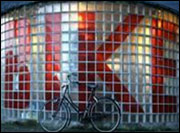
Location: Fort Collins, Colorado
Cost: $132,000 in CMAQ funding (with local match of $33,000)
Project sponsor: City of Fort Collins
Estimated annual emissions reduction benefits:
| Pollutant | Est. Annual Emissions Reduction (kg/yr) |
|---|---|
| CO | 759 |
Project partners included Colorado State University, Downtown Development Authority, Bike Fort Collins (BFC), Fort Collins Bicycle Collective, Fort Collins Convention and Visitors Bureau, and local hotels and businesses.
Responding to a public solicitation by North Front Range Metropolitan Planning Organization (NFRMPO) for CMAQ projects, the City of Fort Collins applied for funding for the Community Bicycle Library project. The proposal was a joint effort by a coalition of partners that included a local university, downtown business groups, and bicycle organizations.
The Fort Collins Community Bicycle Library is a 2-year project (2007-2009) to lend bicycles to the public at no cost. The purpose of the project is to reduce vehicle miles traveled (VMT) and traffic congestion as well as to improve air quality. BFC, a local bicycle advocacy group, administers the Bike Library. Users can borrow one of 100 bikes from two locations in the City of Fort Collins for periods ranging from an hour to a week. The program's Web site, http://www.fcbikelibrary.org, allows users to reserve a bike for future use or to find out if bicycles are available. Web-based tracking allows the project sponsors to document usage. Within the first month of opening, the library was lending bicycles at capacity.
The City estimated that the project would reduce carbon monoxide (CO) by 759 kilograms in the first year of operation. To quantify the air quality benefits of the Bicycle Library, the City worked with the MPO's CMAQ consultant to determine appropriate inputs and assumptions. This required some original research since the project was the first of its type for the MPO and the State.
Using the information submitted by the City, the MPO's CMAQ Selection Committee assigned points for the project on the basis of both quantitative and qualitative measures. This CMAQ proposal was then ranked, along with others, by the Selection Committee, and a recommended list of projects for funding was developed. The MPO makes the final determination of projects to fund.
To evaluate the success of the Bicycle Library, the City of Fort Collins developed a number of metrics and plans to conduct user surveys and collect Web-based data throughout the project to quantify VMT reduction, traffic congestion, and air quality improvements.

The City of Fort Collins and NFRMPO view the CMAQ program as a major success in furthering the goal of broadening the types of projects that are funded. City officials believe that the library is a model for interagency cooperation and that it has already had positive regional and social impacts beyond air quality benefits. It also has furthered the MPO's goal to reach out to nontraditional partners.
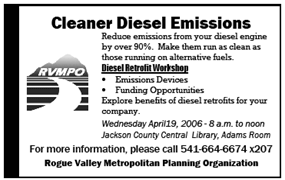
Location: Medford, Oregon
Cost: $50,000 in CMAQ funding (with $50,000 match by Rogue Disposal & Recycling)
Project sponsor: Oregon Department of Environmental Quality (Oregon DEQ)
Estimated annual emissions reduction benefits:
| Pollutant | Est. Annual Emissions Reduction (kg/yr) |
|---|---|
| PM 10 | 6,402 |
Project partners included Rogue Disposal & Recycling, Oregon DEQ, and Rogue Valley Council of Governments (RVCOG).
Rogue Disposal & Recycling, a private waste management and recycling company, learned about the opportunity to apply for CMAQ funds at one of two open houses on diesel retrofits organized by RVCOG staff. Oregon DEQ submitted an application on behalf of the company because only public agencies are eligible to apply for Federal funds from Rogue Valley Metropolitan Planning Organization (RVMPO).
The project goal was to reduce cancer and asthma risk from exposure to diesel emissions by installing emissions control equipment on selected vehicles in the Rogue Disposal & Recycling fleet.
Oregon DEQ staff developed formulas to estimate the air quality benefits of Rogue Disposal & Recycling's diesel retrofits, which cut emissions on each vehicle by 50 percent. Before the retrofit, each vehicle ran on low-sulfur diesel (500 parts per million [ppm]); after the retrofit, each could run on ultra-low-sulfur diesel (15 ppm).
At first, RVMPO's Technical Advisory Committee (TAC) was reluctant to support the project because CMAQ funds had never been given to a private company or used to fund diesel retrofits in the MPO region before. However, Oregon DEQ analysis showed that the project would substantially reduce vehicle emissions, and additional analysis showed that diesel retrofits are more cost-effective, per ton equivalent of air pollution removed, than nearly any other CMAQ-eligible project type. Those analyses provided the foundation for TAC's ultimate recommendation to find the project.
RVMPO does not conduct post-project evaluations for every CMAQ-funded project, but it does require evaluation of diesel retrofits to ensure that air quality targets are met before granting subsequent funding.
After successfully completing this project, the RVMPO Policy Committee sees diesel retrofits as an important and cost-effective component of the CMAQ program. The 2008–2011 TIP obligates $750,800 for five diesel retrofit projects estimated to reduce annual PM 10 emissions by 80.7 tons.
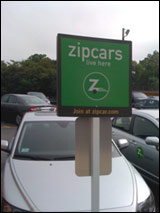
Location: Pittsburgh, Pennsylvania
Cost: $200,000 in CMAQ funding (with $50,000 local match from the Pittsburgh Downtown Partnership)
Project sponsor: Pittsburg Downtown Partnership (PDP)
Estimated annual emissions reduction benefits:
| Pollutant | Est. Annual Emissions Reduction (kg/yr) |
|---|---|
| CO | 4,212 |
| NOx | 456 |
| PM 2.5 | 7 |
PDP submitted a proposal for $200,000 of CMAQ funding during Southwestern Pennsylvania Commission's (SPC) 2005 call for CMAQ projects, with a $50,000 match from PDP. The application was to provide financial support over a 2-year period to get the program started.
PDP wanted to attract car-sharing to downtown Pittsburgh to provide a transportation alternative for residents as well as employers and employees in the area. The idea arose in response to a growing job market and renewed interest in downtown living. Private car-sharing companies had launched successful programs in large cities like New York and San Francisco but were skeptical about the market potential of a midsized city like Pittsburgh. In order to entice private car-sharing companies to invest in the Pittsburgh market, the PDP's CMAQ proposal included funding for a feasibility study, marketing and outreach to expand membership and participation in the program, and revenue guarantees to the private-sector vendor in the initial months of operation until the program became self-sustaining.
It was estimated that the project would reduce carbon monoxide (CO) by 1.54 kilograms per day, nitrogen oxide (NOx) by 1.25 kilograms per day, and fine particulate matter (PM 2.5) by 0.02 kilogram per day. CMAQ had never been used to fund a car-sharing program in Pittsburgh before, so SPC did not have any standard assumptions or calculations for determining air quality benefits. Using membership and follow-up survey data from Philly CarShare, which had been in operation for several years at that point, Pennsylvania Department of Transportation's on-call CMAQ consultant developed assumptions about travel behavior change to calculate the air quality impacts of car-sharing and establish the project's funding eligibility.
After refining the calculation of air quality benefits and the cost-effectiveness measures, the project was evaluated by the SPC CMAQ Evaluation Committee. The committee reviewed the project assumptions and voted to include the project among the recommended set of CMAQ projects in the 2007-2010 Transportation Improvement Program, which was adopted by SPC in June 2006.
CMAQ funds were used over a 2-year period during start-up of the Pittsburgh car-sharing program. During that period, PDP tracked program usage and provided regular reports to SPC. The pilot was successful. The Pittsburgh car-share is now self-supporting and is slowly growing and expanding on its own.
PDP believes that there are desirable outcomes beyond the air quality benefits for the project. The additional benefits include positively affecting the economic vitality of the downtown area and providing employees and residents with alternative travel options.
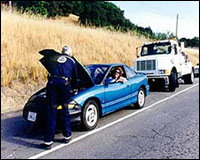
Location: San Francisco, California
Cost: $5 million (CMAQ funds used for an average of approximately 10 percent of total cost)
Project sponsors: MTC Service Authority for Freeways and
Expressways (MTC SAFE), California Highway Patrol (CHP), California DOT (Caltrans)
Estimated annual emissions reduction benefits:
| Pollutant | Est. Annual Emissions Reduction (kg/yr) |
|---|---|
| CO | 95,000 |
| NOx | 445,000 |
Project partners included CHP, MTC SAFE, Caltrans, and private tow contractors in the region.
MTC SAFE does not apply for CMAQ funds through a standard fund application process; rather, funding for this program is supported by the operational strategy goals paid out in the Regional Transportation Plan (RTP). Specific funding levels are established cooperatively with MTC's transportation partners while considering how to strike the best balance among programs.
The purpose of FSP is to improve freeway safety, reduce congestion caused by vehicle accidents and incidents, and enhance air quality by reducing stop-and-go traffic. MTC SAFE primarily administers FSP, while CHP has field operation and supervision responsibilities. Caltrans provides data collection and route assessment support. A fleet of 85 specialized, state-of-the-art tow trucks patrol 35 routes stretching 540 miles on the Bay Area's freeways, and offer assistance to stranded motorists. Tow-truck drivers also clear road debris to keep traffic moving. The tow trucks primarily operate during the morning and afternoon weekday commuting hours. The Bay Area FSP, which began in 1992, was modeled on a program that started in Los Angeles in July 1991. On average, FSP drivers annually assist approximately 670,000 vehicles.
The project was estimated to reduce 19 kilograms per year of reactive organic gases, 445 kilograms per year of nitrogen oxide (NOx) and 95 kilograms per year of carbon monoxide (CO). MTC SAFE developed a benefit-cost model to assess cost, fuel, and air quality benefits of FSP. It estimated that FSP provides 2,278 hours of delay savings and 5,818 gallons of fuel savings, for a benefit-cost ratio of 3.6:1.
MTC SAFE does not use a uniform scoring method to select projects for CMAQ funding. The primary criterion is the extent to which projects meet goals in the long-range RTP. RTP program area contacts may develop additional criteria or methods to identify CMAQ-eligible projects.
MTC SAFE conducts post-project evaluations for selected projects, including FSP. A performance evaluation conducted for FSP indicated that the program was very cost-effective. This finding provided a basis of support for MTC SAFE to continue funding and expanding the program.
MTC SAFE believes that the FSP program is a cost-effective strategy to meet regional planning goals of improving safety and air quality while reducing congestion. Due to the ongoing benefits of the program, MTC SAFE believes it would continue to fund FSP even if CMAQ funds were unavailable.